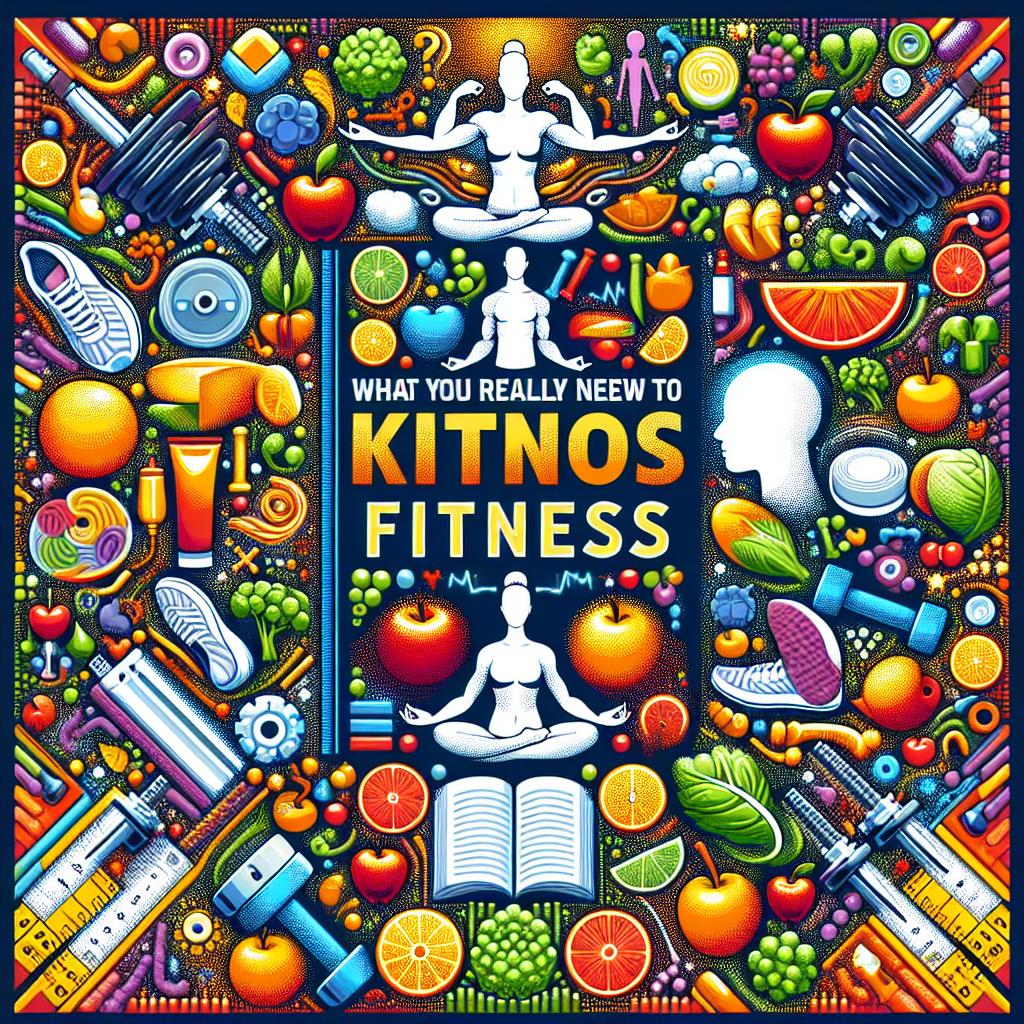What You Really Need to Know About Fitness

Discover what you really need to know about fitness! Empower your health journey by gaining essential knowledge and tips. Visit My Vibrant Vitality now.
Understanding the Essential Elements of Fitness
Fitness is a term that is often thrown around in casual conversation, but what does it truly mean? In essence, fitness is a state of health and well-being, and more specifically, the ability to perform aspects of sports, occupations, and daily activities. It is not merely about having a toned body or the ability to lift heavy weights. Rather, it encompasses a broad spectrum of physical capabilities, including strength, flexibility, endurance, and coordination.
To begin with, strength is a fundamental element of fitness. It is the ability of your muscles to exert force against resistance. Strength training, which involves exercises like weight lifting and resistance band workouts, is crucial for building and maintaining muscle mass. It also plays a significant role in preventing injuries, improving bone density, and boosting metabolism. However, strength is not just about physical power. It also involves mental resilience, which is the capacity to persevere through challenging workouts and push beyond your comfort zone.
Next, flexibility is another key component of fitness. It refers to the range of motion available at your joints. Regular stretching exercises can enhance your flexibility, thereby improving your performance in physical activities and reducing your risk of injuries. Moreover, flexibility exercises can help alleviate muscle stiffness and soreness, promote relaxation, and improve posture and alignment.
Endurance, or cardiovascular fitness, is the ability of your heart, lungs, and blood vessels to deliver oxygen to your muscles during prolonged physical activity. Activities that boost endurance include running, swimming, cycling, and high-intensity interval training (HIIT). Regular endurance training can help lower your risk of heart disease, diabetes, and other chronic conditions. It can also improve your stamina, enabling you to perform daily tasks more efficiently.
Coordination, the ability to move different parts of your body smoothly and efficiently, is often overlooked in discussions about fitness. However, it is vital for performing complex movements in sports and daily life. Balance exercises, agility drills, and dance classes can help improve your coordination.
In addition to these physical elements, fitness also involves a mental component. Regular physical activity can boost your mood, reduce stress and anxiety, and improve your sleep. It can also enhance your self-esteem and body image. Furthermore, setting and achieving fitness goals can foster a sense of accomplishment and resilience.
Nutrition is another crucial aspect of fitness. A balanced diet, rich in fruits, vegetables, lean proteins, and whole grains, can provide the energy and nutrients needed for physical activity. It can also aid in muscle recovery and repair after workouts. Moreover, staying hydrated is essential for maintaining your performance during exercise and preventing dehydration.
Lastly, rest and recovery are integral to fitness. They allow your body to repair and strengthen itself between workouts. Getting adequate sleep and taking rest days can help prevent overtraining, which can lead to injuries and hinder your progress.
In conclusion, fitness is a multifaceted concept that involves more than just physical prowess. It encompasses strength, flexibility, endurance, and coordination, as well as mental well-being, nutrition, and recovery. By understanding these essential elements, you can create a balanced fitness routine that caters to your unique needs and goals. Remember, fitness is not a destination, but a lifelong journey of self-improvement and well-being.
The Truth About Fitness: Debunking Common Myths

Fitness is a topic that has been widely discussed, yet it remains shrouded in misconceptions and myths. As we delve into the truth about fitness, it is essential to debunk these common myths that often mislead individuals on their journey to a healthier lifestyle.
Firstly, one of the most prevalent myths is that exercise alone can lead to weight loss. While physical activity is a crucial component of weight management, it is not the sole determinant. A balanced diet plays an equally, if not more, significant role. Consuming a diet rich in fruits, vegetables, lean proteins, and whole grains can help maintain a healthy weight. Moreover, it is important to remember that weight loss should not be the ultimate goal; instead, the focus should be on overall health and well-being.
Another common misconception is that more exercise is always better. This is not necessarily true. Over-exercising can lead to injuries and burnout. It is crucial to listen to your body and give it adequate rest. The key is to find a balance between exercise and rest. This balance will vary from person to person, depending on factors such as age, fitness level, and overall health.
The myth that strength training will make you bulky is another misconception that needs debunking. Strength training is an essential part of a balanced fitness routine. It helps build lean muscle mass, which can boost your metabolism and help you burn more calories, even at rest. Moreover, strength training does not necessarily lead to bulkiness. The degree of muscle growth depends on various factors, including genetics and diet.
The belief that cardio is the only way to lose weight is another myth that needs to be dispelled. While cardio exercises like running, cycling, and swimming are great for improving cardiovascular health and burning calories, they are not the only way to lose weight. Strength training, as mentioned earlier, can also contribute to weight loss by increasing muscle mass and boosting metabolism.
Lastly, the notion that you need to spend hours in the gym to see results is a myth. Quality trumps quantity when it comes to exercise. Short, intense workouts can be just as effective, if not more so, than longer, less intense ones. High-intensity interval training (HIIT), for example, involves short bursts of intense exercise followed by brief periods of rest. Studies have shown that HIIT can be incredibly effective for weight loss and improving cardiovascular health.
In conclusion, the journey to fitness is not a one-size-fits-all approach. It involves a combination of regular exercise, a balanced diet, and adequate rest. It is important to debunk common fitness myths and understand the truth about fitness to make informed decisions about your health. Remember, the goal is not to achieve a certain look or number on the scale, but to lead a healthier, happier life.
The Role of Nutrition in Achieving Your Fitness Goals
When it comes to achieving your fitness goals, there’s a lot more to consider than just the amount of time you spend in the gym. One of the most critical, yet often overlooked, aspects of fitness is nutrition. The food you consume plays a pivotal role in determining your overall health and fitness levels. It fuels your body for workouts, aids in recovery post-exercise, and helps build and repair muscles. Therefore, understanding the role of nutrition in fitness is essential for anyone looking to improve their physical health.
To begin with, let’s consider the importance of macronutrients – proteins, carbohydrates, and fats. Each of these plays a unique role in supporting your fitness journey. Proteins, for instance, are the building blocks of muscle tissue. Consuming an adequate amount of protein can help enhance muscle growth and repair, especially after a strenuous workout. Carbohydrates, on the other hand, are your body’s primary source of energy. They provide the fuel you need to power through your workouts. Lastly, fats, often misunderstood and vilified, are essential for numerous bodily functions, including hormone production and nutrient absorption.
However, it’s not just about consuming these macronutrients, but also about getting them in the right proportions. A balanced diet that includes a mix of proteins, carbohydrates, and healthy fats can significantly enhance your fitness results. The exact proportions may vary based on individual goals, body type, and workout intensity. For instance, someone looking to build muscle mass may need a higher proportion of protein, while an endurance athlete may require more carbohydrates for sustained energy.
In addition to macronutrients, micronutrients – vitamins and minerals – also play a crucial role in fitness. They help regulate a host of bodily functions, from bone health to immune function, and even energy production. A deficiency in any of these micronutrients can hinder your fitness progress and overall health. Therefore, it’s essential to include a variety of nutrient-dense foods in your diet to meet your micronutrient needs.
Hydration is another critical aspect of fitness nutrition. Water plays a vital role in almost every bodily function, including digestion, nutrient absorption, and even muscle contraction. Staying adequately hydrated can help improve your workout performance and recovery. Moreover, it can also aid in weight management by helping control hunger and maintain a healthy metabolism.
Lastly, it’s important to remember that nutrition is not a one-size-fits-all concept. Each individual has unique nutritional needs based on their age, sex, activity level, and overall health. Therefore, it’s advisable to consult with a registered dietitian or a nutritionist who can provide personalized advice based on your specific needs and goals.
In conclusion, nutrition plays a fundamental role in achieving your fitness goals. It’s not just about eating less or more, but about eating right. A balanced diet, rich in macronutrients and micronutrients, coupled with adequate hydration, can significantly enhance your fitness results. So, the next time you plan your fitness routine, remember to give equal importance to your diet. After all, you can’t out-exercise a bad diet.